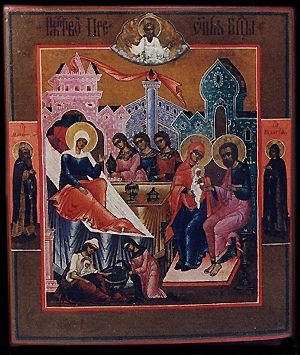

Christmas In Victorian England
Although Christ's Nativity has been celebrated
since the 4th century,
most of the English customs we are familiar with
today
are as recent as the mid-19th century.
Many of the early ceremonies were rooted in pagan
beliefs,
and some customs, like wassailing, still survive.

The Protestant Reformation condemned most of these
pagan
customs as superstitious and banned public celebrations
of Christmas.
The Puritans abolished all celebrations after
the Civil War,
also. Fervor for the holiday declined even into
the Georgian Era.
It wasn't until Prince Albert married Queen Victoria
and brought many German customs with him that
Christmas began to gain popularity again.

One of the first signs of Christmas was the arrival
of the Christmas card in the post. John Calcott
Horsley
designed the first Christmas card in 1846 for
Sir Henry Cole,
Chairman of the Society of the Arts.
Only 1000 cards were printed that first year
and were expensive,
but the pattern for the future was formed.
Then in 1870, postage was reduced to one half
penny
per ounce and a cheaper color lithography was
used for printing.
Thus began the real spread of the Christmas card.
By the early 1870s, the custom had reached the
United States.
At first, designs were simple, but as technology
advanced,
new subjects evolved. By the 1860s,
popular designs were Christmas feasts,
church bells, snowbound mail-coaches and turkey
and plum puddings.

Christmas decorations sometimes appeared well
before the holiday,
also, but many still held to the old superstition
of bad luck to erect evergreens before Christmas
Eve.
The most favored plants were all 'magical' because
of the mid-winter berries they produced--mistletoe,
holly and ivy.
The red berry of the holly was believed to protect
one against witchcraft.
The sprig had to be carried into the house by
a male,
as the berry is on the 'male' holly plant.
One use for holly sprigs was to decorate the
Christmas pudding.
The 'female' ivy symbolized immortality.
Mistletoe, because of its pagan origins,
was not allowed in any church.
Kissing under the mistletoe was a purely English
custom,
and only as many berries as were on the mistletoe,
could there be kisses.
For after every kiss, a berry had to be removed
from the sprig.

The Christmas tree can truly be called a Victorian
innovation.
The custom of a lighted tree began in Germany
and German settlers brought the idea to America.
But it wasn't until Prince Albert, of German
descent,
brought the Christmas tree to England in 1840
that it gained popularity there.
By 1847, the trees at Windsor Castle
were laden with presents as well as wax candles.
The tradition spread as English citizens followed
the Royal example.
The trees and other decorations were removed
on Twelfth Night (January 6).
To do so before or after was considered bad luck.

Families began their Christmas Day by celebrating
mass.
(Christmas Eve services did not become
popular until after the Second World War.)
The peal of bells called everyone to church.
At services, scriptural lessons were interspersed
with carols.
Most of the carols we sing today were written
in the nineteenth century,
although old favorites such as 'Silent Night'
and 'Hark the Herald Angels Sing' are much older.

Carols were also sung at home and families
even walked door-to-door to entertain others.
Also going from house-to-house were the wassailers.
These were usually the poor of the parish,
who sought donations of drink,
food or money as they invited
others to drink from their wooden bowl.

Christmas dinner was a grand affair.
Goose, chicken or a joint of roast beef
took
center stage on the table.
Turkey, while popular in America,
wasn't customary fare until late in the 19th
century in England.
Christmas pudding, made with beef, raisins and
prunes,
was mixed on Stir-up Sunday,
the Sunday before Advent, in order for the mixture
to mature.
All present in the house took turns stirring
the pudding
with a wooden spoon
(in honor of the Christ child's wooden crib).
The stirring had to be done in a clockwise direction
for luck.
Mince pies were another traditional dish.
They were sweeter, made with mincemeat, fruit
and spices,
and had to be eaten for the twelve days of Christmas
to ensure twelve months of luck in the coming
year.
Each one eaten had to be baked by a different
person,
however, so there was much sharing with friends.

After dinner, children pulled their
crackers and everyone exchanged gifts.
The evening usually ended with parlor games and
carol singing.
by Michelle J. Hoppe

For more information on
Christmas
customs in the 19th century,
I suggest the following references:
Discovering Christmas Customs and Folklore
by Margaret Baker, 1994,
Shire Publications Ltd. ISBN#0747801754
The Customs and Ceremonies of Britain
by Charles Kightly,
Thames and Hudson Ltd. ISBN#0500275378

